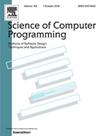基于在线策略综合的可证明的针转向问题安全控制器
IF 1.4
4区 计算机科学
Q3 COMPUTER SCIENCE, SOFTWARE ENGINEERING
引用次数: 0
摘要
自治系统经常解决复杂的规划问题,这需要前瞻性的行动计划和回顾性的数据评估。定时游戏能够提供帮助,因为它们能够自动合成能够解决这些计划问题的策略;然而,他们假设环境的静态模型,这对于自治系统来说是不现实的。然而,许多自治系统是控制应用程序,它们使用传感器在运行时捕获系统行为,从而可以在建模时补偿不完整的知识。在本文中,我们提出了一种在线策略综合,该策略综合一方面基于离线策略综合,另一方面基于关于物理世界当前状态的传感器信息,在响应和适应环境变化的同时获得正式的安全保证。我们将医疗机器人的针导向问题形式化,即,通过将其解释为一个定时游戏,将(灵活且倾斜的)针通过部分未知组织指向目标而不破坏其周围环境的问题。此外,我们通过不同的区域类型引入了其环境的新表示,这些区域类型决定了行动计划的接受程度并触发了局部纠正行动。我们提出了一种在线策略综合算法,对于给定的区域表示,我们正式证明了它返回安全的在线控制器。该算法是在Uppaal策略的基础上实现的。对于针导向、硬膜外麻醉和预先定义的针轨迹这两种医学应用,我们在一系列对环境有不同程度初始知识的模拟中证明了在线调整的必要性,并表明在线合成的开销仍然是实用的。本文章由计算机程序翻译,如有差异,请以英文原文为准。
A provably safe controller for the needle-steering problem using online strategy synthesis
Autonomous systems often address complex planning problems, which require both prospective action planning and retrospective data evaluation. Timed games could aid since they automatically synthesize strategies that, provably correct, solve those planning problems; yet, they assume a static model of the environment, which is not realistic for autonomous systems. However, many autonomous systems are control applications, which employ sensors that capture system behavior at run time and can thus compensate for incomplete knowledge at modeling time. In this paper, we propose an online strategy synthesis, which, based on offline strategy synthesis on the one hand and on sensor information about the current state of the physical world on the other hand, derives formal safety guarantees while reacting and adapting to environment changes. We formalize the needle-steering problem from medical robotics, i.e., the problem of navigating a (flexible and beveled) needle through partially unknown tissue towards a target without damaging its surroundings, by interpreting it as a timed game. Further, we introduce a new representation of its environment through different region types that determine the acceptance of action plans and trigger local correcting actions. We present an algorithm for online strategy synthesis and, for the given region representation, formally prove that it returns safe online controllers. The algorithm is implemented on top of Uppaal Stratego. For two medical applications of needle steering, peridural anesthesia and predefined needle trajectory, we demonstrate the necessity of online adjustments in a series of simulations with various degrees of initial knowledge about the environment, and show that the overhead of online synthesis remains practical.
求助全文
通过发布文献求助,成功后即可免费获取论文全文。
去求助
来源期刊

Science of Computer Programming
工程技术-计算机:软件工程
CiteScore
3.80
自引率
0.00%
发文量
76
审稿时长
67 days
期刊介绍:
Science of Computer Programming is dedicated to the distribution of research results in the areas of software systems development, use and maintenance, including the software aspects of hardware design.
The journal has a wide scope ranging from the many facets of methodological foundations to the details of technical issues andthe aspects of industrial practice.
The subjects of interest to SCP cover the entire spectrum of methods for the entire life cycle of software systems, including
• Requirements, specification, design, validation, verification, coding, testing, maintenance, metrics and renovation of software;
• Design, implementation and evaluation of programming languages;
• Programming environments, development tools, visualisation and animation;
• Management of the development process;
• Human factors in software, software for social interaction, software for social computing;
• Cyber physical systems, and software for the interaction between the physical and the machine;
• Software aspects of infrastructure services, system administration, and network management.
 求助内容:
求助内容: 应助结果提醒方式:
应助结果提醒方式:


